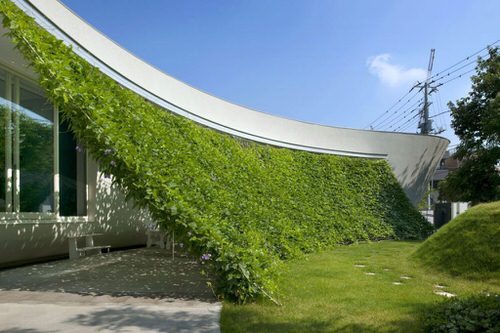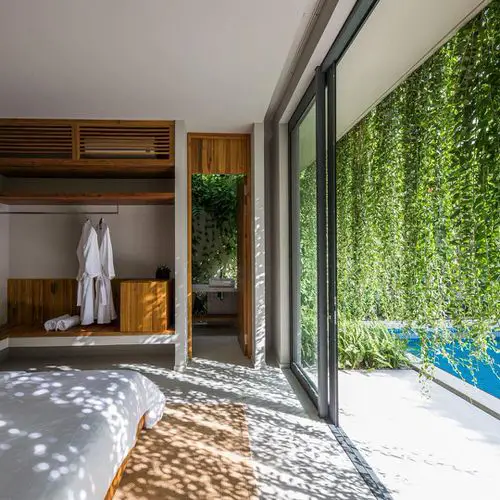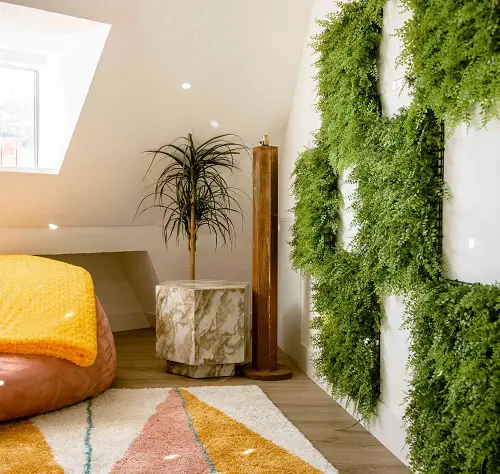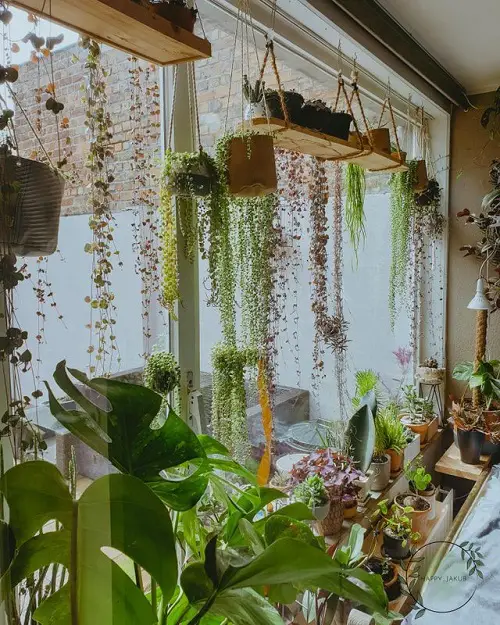Wondering What is a Green Curtain? If you want to know How to Grow a Living Plant Curtain, then here are all the details for you!

Growing a uniform array of plants is one of the best ways to enjoy privacy and get a calm and relaxing feeling. It also helps block the sun if grown outdoors, resulting in energy savings! Here’s all you need to know about How to Grow a Living Plant Curtain in the simplest way!
Check out the best ways to block neighbor’s view in gardens and backyards here
What is a Green Curtain?

According to a study, adding green elements around the home environment is an excellent way to lower stress and anxiety levels. A green curtain will ensure you always have a connection to nature indoors.
Outdoors–green curtains are plant installations on the side of buildings, homes, offices, or any place you would like them to be. Having them is the best way to add some greenery while combating the sun’s heating effect.
Living curtains in homes, offices, or public spaces provide a constant visual link to the natural world. This visual connection helps reduce stress and anxiety, improve mental well-being, and enhance overall quality of life.
Check out the best green curtain ideas here
How to Grow a Living Plant Curtain

1. Choosing a Location
Selecting the right location is critical for the success of your green curtain. For indoor curtains, ensure that the chosen spot provides adequate light while avoiding harsh direct sunlight. For outdoor curtains, consider the specific light conditions, climate, and aesthetics of the chosen location. The location sets the stage for the growth and visual impact of the green curtain.
2. Best Indoor Plants for Living Green Curtain
Consider factors like light requirements and climate when selecting plants for your green curtain. Here are some suitable options:
- Peperomias: Ideal for indoor green curtains, they thrive in low to medium light and have attractive foliage.
- Pothos: It’s the number one plant for this purpose.
- Black-Eyed Susan Vine: A vibrant outdoor option that blooms with orange or yellow flowers.
- Jasmine: An aromatic outdoor choice with fragrant flowers.
- Morning Glory: Known for its quick growth and vibrant, trumpet-shaped flowers.
- English Ivy: Hardy and cascading, English Ivy provides a living green curtain with its vigorous growth and trailing vines.
- Curtain Creeper: An ideal choice for a natural green curtain, the Curtain Creeper offers dense foliage and easy maintenance.
- Philodendron: With its lush leaves and adaptable nature, Philodendron serves as a practical living green curtain for indoor spaces.
- String of Pickles: Uniquely trailing and resilient, the String of Pickles is a simple yet effective choice for creating a green curtain indoors.
Check out some Amazing Indoor Vining Plants here
How to Make a Green Curtain Indoors?

1. Choosing a Location
Select a location with bright, indirect light for your indoor green curtain. Avoid areas with excessive drafts or direct sunlight.
2. Selecting the Right Plants
Choose suitable plants that thrive indoors. Some options include peperomias, pothos, or heart-leaf philodendron.
3. Creating the Curtain
Train the vines to cascade like a curtain by placing pots on shelves, hanging them, or using hooks to guide their growth.
4. Care and Maintenance
Water the plants when the soil is dry, provide adequate light, and avoid waterlogging. Use netting for support, and clean the leaves regularly.
5. Creative Ways to Set Up Green Curtains
- Installing shelves and placing potted plants on them.
- Using wall hooks or brackets to guide the growth of trailing plants.
- Hanging plants from the ceiling with S-hooks for a cascading effect.
- Use tension rods with curtain clips to suspend trailing plants in front of windows.
Taking Care of Green Curtains
- Water the vines frequently but carefully when the soil seems dry.
- Make sure the plants get plenty of bright and indirect light for dense growth and look.
- Avoid waterlogging, as root rot might spoil the lush look.
- Use a foliar spray to feed the plants, if possible, clean the leaves often.
- For a better look, you can also use netting across the window or a wall to ensure the vines trail properly and in shape.
Check out the video to make a green curtain here
Outdoor Places that Can Benefit from Green Curtains

Location Matters
Identify the outdoor area where you want to create a green curtain. Ensure it receives the appropriate amount of sunlight based on the chosen plants.
Plant Selection
Choose outdoor plants that thrive in your climate, such as black-eyed susan vine, jasmine, cucumber, morning glory, pole beans, curtain creeper, hyacinth bean vine, English ivy, Virginia creeper, or perennials for an everlasting show.
Installation and Training
Plant the selected vines or climbers near the designated structure. Use trellises, fences, or other supports to guide their growth and create a curtain effect.
Maintenance
Water the outdoor green curtain as needed, provide proper sunlight, and monitor growth to ensure it achieves the desired visual impact.
Green curtains can be used outdoors in various settings:
- On the sides of buildings to enhance aesthetics and provide shade.
- Along garden fences for privacy and an appealing green backdrop.
- In yard spaces, create natural partitions or windbreaks.
- Suitable plant species depend on the local climate and preferences.
- Choose from options like jasmine, cucumber, morning glory, and more based on the outdoor setting.
Check out our article How to Grow Big-Size Succulents Faster (8 Incredible Tips) here
Benefits of Green Curtains
Improving Indoor Air Quality
Green curtains act as natural air purifiers. Many plant species, such as pothos and spider plants, have the ability to remove pollutants from the air, contributing to a healthier indoor environment. This can lead to improved respiratory health and overall well-being for those inhabiting the space.
Reducing Energy Consumption
When strategically placed outdoors, green curtains can provide shade, reducing the impact of direct sunlight on buildings. This natural shading effect helps lower indoor temperatures, reducing the need for air conditioning and reducing energy consumption. This contributes to both environmental sustainability and cost savings.
Adding Aesthetic Value
Beyond their practical benefits, green curtains enhance the visual appeal of indoor and outdoor spaces. The vibrant colors, textures, and shapes of the plants create a visually pleasing and calming atmosphere. Green curtains can serve as living works of art, transforming walls, fences, or balconies into natural, living canvases.
Creative Ideas for Green Curtain Display
1. Living Wall Art
Arrange a variety of plants in a visually striking pattern on a vertical surface, creating a living masterpiece. This approach turns the green curtain into a unique focal point in any room or outdoor area.
2. Hanging Gardens
Use creative hanging mechanisms such as macramé plant hangers, colorful ropes, or decorative hooks to suspend plants from ceilings or structures. This not only adds an artistic touch but also maximizes the use of vertical space.
3. Theme-Based Curtains

Tailor your green curtain to match specific themes or color schemes. For example, create a tropical paradise with lush, exotic plants, or opt for a minimalist look with uniform and sleek foliage. This customization allows individuals to express their style and preferences.
4. Interactive Green Curtains
Incorporate edible plants like herbs into your green curtain. This not only adds functionality to the curtain but also allows for an interactive and sustainable element where residents can harvest fresh herbs for culinary use.
5. Mixed Media Green Curtains
Combine plants with other design elements such as fairy lights, decorative stones, or small water features to create a multi-dimensional and visually appealing green curtain. This fusion of nature and design elements can bring a touch of magic to any space.


